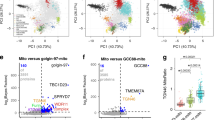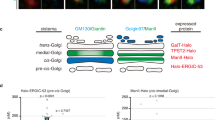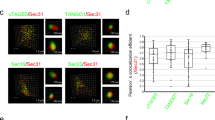Abstract
The organization of secretory traffic remains unclear, mainly because of the complex structure and dynamics of the secretory pathway. We have thus studied a simplified system, a single synchronized traffic wave crossing an individual Golgi stack, using electron tomography. Endoplasmic-reticulum-to-Golgi carriers join the stack by fusing with cis cisternae and induce the formation of intercisternal tubules, through which they redistribute their contents throughout the stack. These tubules seem to be pervious to Golgi enzymes, whereas Golgi vesicles are depleted of both enzymes and cargo. Cargo then traverses the stack without leaving the cisternal lumen. When cargo exits the stack, intercisternal connections disappear. These findings provide a new view of secretory traffic that includes dynamic intercompartment continuities as key players.
This is a preview of subscription content, access via your institution
Access options
Subscribe to this journal
Receive 12 print issues and online access
$209.00 per year
only $17.42 per issue
Buy this article
- Purchase on Springer Link
- Instant access to full article PDF
Prices may be subject to local taxes which are calculated during checkout






Similar content being viewed by others
References
Bannykh, S. I. & Balch, W. E. Membrane dynamics at the endoplasmic reticulum–Golgi interface. J. Cell Biol. 138, 1–4 (1997).
Mironov, A. A., Weidman, P. & Luini, A. Variations on the intracellular transport theme: maturing cisternae and trafficking tubules. J. Cell Biol. 138, 481–484 (1997).
Bonfanti, L. et al. Procollagen traverses the Golgi stack without leaving the lumen of cisternae: evidence for cisternal maturation. Cell 95, 993–1003 (1998).
Glick, B. S. & Malhotra, V. The curious status of the Golgi apparatus. Cell 95, 883–889 (1998).
Pelham, H. R. Traffic through the Golgi apparatus. J. Cell Biol. 155, 1099–1101 (2001).
Weiss, M. & Nilsson, T. Protein sorting in the Golgi apparatus: a consequence of maturation and triggered sorting. FEBS Lett. 486, 2–9 (2000).
Martinez-Menarguez, J. A. et al. Peri-Golgi vesicles contain retrograde but not anterograde proteins consistent with the cisternal progression model of intra-Golgi transport. J. Cell Biol. 155, 1213–1224 (2001).
Lanoix, J. et al. GTP hydrolysis by arf-1 mediates sorting and concentration of Golgi resident enzymes into functional COP I vesicles. EMBO J. 18, 4935–4948 (1999).
Cosson, P., Amherdt, M., Rothman, J. E. & Orci, L. A resident Golgi protein is excluded from peri-Golgi vesicles in NRK cells. Proc. Natl Acad. Sci. USA 99, 12831–12834 (2002).
Kweon, H. S. et al. Golgi enzymes are enriched in perforated zones of Golgi cisternae but excluded from peri-Golgi vesicles. Mol. Biol. Cell (in the press).
Pelham, H. R. EJCB-Lecture. SNAREs and the organization of the secretory pathway. Eur. J. Cell Biol. 74, 311–314 (1997).
Klumperman, J. Transport between ER and Golgi. Curr. Opin. Cell Biol. 12, 445–449 (2000).
Hauri, H. P., Kappeler, F., Andersson, H. & Appenzeller, C. ERGIC-53 and traffic in the secretory pathway. J. Cell Sci. 113, 587–596 (2000).
Ladinsky, M. S., Mastronarde, D. N., McIntosh, J. R., Howell, K. E. & Staehelin, L. A. Golgi structure in three dimensions: functional insights from the normal rat kidney cell. J. Cell Biol. 144, 1135–1149 (1999).
Polishchuk, R. S. et al. Correlative light-electron microscopy reveals the tubular-saccular ultrastructure of carriers operating between Golgi apparatus and plasma membrane. J. Cell Biol. 148, 45–58 (2000).
Mironov, A. A. et al. Small cargo proteins and large aggregates can traverse the Golgi by a common mechanism without leaving the lumen of cisternae. J. Cell Biol. 155, 1225–1238 (2001).
Rambourg, A. & Clermont, Y. Three-dimensional electron microscopy: structure of the Golgi apparatus. Eur. J. Cell Biol. 51, 189–200 (1990).
Cole, N. B., Sciaky, N., Marotta, A., Song, J. & Lippincott-Schwartz, J. Golgi dispersal during microtubule disruption: regeneration of Golgi stacks at peripheral endoplasmic reticulum exit sites. Mol. Biol. Cell 7, 631–650 (1996).
Neumann, U., Brandizzi, F. & Hawes, C. Protein transport in plant cells: in and out of the Golgi. Ann. Bot. (Lond.) 92, 167–180 (2003).
Rabouille, C. et al. The Drosophila GMII gene encodes a Golgi alpha-mannosidase II. J. Cell Sci. 112, 3319–3330 (1999).
Thyberg, J. & Moskalewski, S. Role of microtubules in the organization of the Golgi complex. Exp. Cell Res. 246, 263–279 (1999).
Kuismanen, E. & Saraste, J. Low temperature-induced transport blocks as tools to manipulate membrane traffic. Methods Cell Biol. 32, 257–274 (1989).
Marsh, B. J., Mastronarde, D. N., Buttle, K. F., Howell, K. E. & McIntosh, J. R. Organellar relationships in the Golgi region of the pancreatic beta cell line, HIT-T15, visualized by high resolution electron tomography. Proc. Natl Acad. Sci. USA 98, 2399–2406 (2001).
Bergmann, J. E. Using temperature-sensitive mutants of VSV to study membrane protein biogenesis. Methods Cell Biol. 32, 85–110 (1989).
Aridor, M., Bannykh, S. I., Rowe, T. & Balch, W. E. Cargo can modulate COPII vesicle formation from the endoplasmic reticulum. J. Biol. Chem. 274, 4389–4399 (1999).
Aridor, M. et al. The Sar1 GTPase coordinates biosynthetic cargo selection with endoplasmic reticulum export site assembly. J. Cell Biol. 152, 213–229 (2001).
Keller, P., Toomre, D., Diaz, E., White, J. & Simons, K. Multicolour imaging of post-Golgi sorting and trafficking in live cells. Nat. Cell Biol. 3, 140–149 (2001).
Pelham, H. R. Recycling of proteins between the endoplasmic reticulum and Golgi complex. Curr. Opin. Cell Biol. 3, 585–591 (1991).
Orci, L., Schekman, R. & Perrelet, A. Interleaflet clear space is reduced in the membrane of COP I and COP II-coated buds/vesicles. Proc. Natl Acad. Sci. USA 93, 8968–8970 (1996).
Polishchuk, E. V., Di Pentima, A., Luini, A. & Polishchuk, R. S. Mechanism of constitutive export from the golgi: bulk flow via the formation, protrusion, and en bloc cleavage of large trans-golgi network tubular domains. Mol. Biol. Cell 14, 4470–4485 (2003).
Pelham, H. R. & Rothman, J. E. The debate about transport in the Golgi--two sides of the same coin? Cell 102, 713–719 (2000).
Volchuk, A. et al. Countercurrent distribution of two distinct SNARE complexes mediating transport within the Golgi stack. Mol. Biol. Cell 15, 1506–1518 (2004).
Pelham, H. Getting stuck in the Golgi. Traffic 1, 191–192 (2000).
Bretscher, M. S. & Munro, S. Cholesterol and the Golgi apparatus. Science 261, 1280–1281 (1993).
Munro, S. An investigation of the role of transmembrane domains in Golgi protein retention. EMBO J. 14, 4695–4704 (1995).
Cluett, E. B., Kuismanen, E. & Machamer, C. E. Heterogeneous distribution of the unusual phospholipid semilysobisphosphatidic acid through the Golgi complex. Mol. Biol. Cell 8, 2233–2240 (1997).
Holthuis, J. C., Pomorski, T., Raggers, R. J., Sprong, H. & Van Meer, G. The organizing potential of sphingolipids in intracellular membrane transport. Physiol. Rev. 81, 1689–1723 (2001).
Maxfield, F. R. & Wustner, D. Intracellular cholesterol transport. J. Clin. Invest. 110, 891–898 (2002).
Mitra, K., Ubarretxena-Belandia, I., Taguchi, T., Warren, G. & Engelman, D. M. Modulation of the bilayer thickness of exocytic pathway membranes by membrane proteins rather than cholesterol. Proc. Natl Acad. Sci. USA 101, 4083–4088 (2004).
Marra, P. et al. The GM130 and GRASP65 Golgi proteins cycle through and define a subdomain of the intermediate compartment. Nat. Cell Biol. 3, 1101–1113 (2001).
Seemann, J., Jokitalo, E., Pypaert, M. & Warren, G. Matrix proteins can generate the higher order architecture of the Golgi apparatus. Nature 407, 1022–1026 (2000).
Mironov, A. Jr, Luini, A. & Mironov, A. A synthetic model of intra-Golgi traffic. Faseb J. 12, 249–252 (1998).
Hirschberg, K., Phair, R. D. & Lippincott-Schwartz, J. Kinetic analysis of intracellular trafficking in single living cells with vesicular stomatitis virus protein G-green fluorescent protein hybrids. Methods Enzymol. 327, 69–89 (2000).
Weidman, P. J. Anterograde transport through the Golgi complex: do Golgi tubules hold the key? Trends Cell Biol. 5, 302–305 (1995).
Beznoussenko, G. V. & Mironov, A. A. Models of intracellular transport and evolution of the Golgi complex. Anat. Rec. 268, 226–238 (2002).
Horton, A. C. & Ehlers, M. D. Dual modes of endoplasmic reticulum-to-Golgi transport in dendrites revealed by live-cell imaging. J. Neurosci. 23, 6188–6199 (2003).
Marsh, B. J., Volkmann, N., McIntosh, J. R. & Howell, K. E. Direct continuities between cisternae at different levels of the Golgi complex in glucose-stimulated mouse islet beta cells. Proc. Natl Acad. Sci. USA 101, 5565–5570 (2004).
Nicolas, M. T., Bassot, J. M. & Nicolas, G. Immunogold labeling of luciferase in the luminous bacterium Vibrio harveyi after fast-freeze fixation and different freeze-substitution and embedding procedures. J. Histochem. Cytochem. 37, 663–674 (1989).
Koster, A. J. et al. Perspectives of molecular and cellular electron tomography. J. Struct. Biol. 120, 276–308 (1997).
Acknowledgements
A. Mironov and A. Luini are principal investigators and have contributed equally to this project. We would like to thank all those who provided us with antibodies and cDNAs, P. Lupetti for assistance with fast-freezing experiments, C. P. Berrie for critical reading of the manuscript and E. Fontana for artwork preparation. We acknowledge financial support from the AIRC, Telethon Italy and a European Research Training Network (A.L. and K.N.J.B.). A.J.K. is supported by the Royal Netherlands Academy of Arts and Sciences (KNAW), and W.J.C.G. and K.N.J.B. by FEI.
Author information
Authors and Affiliations
Corresponding authors
Ethics declarations
Competing interests
The authors declare no competing financial interests.
Supplementary information
Rights and permissions
About this article
Cite this article
Trucco, A., Polishchuk, R., Martella, O. et al. Secretory traffic triggers the formation of tubular continuities across Golgi sub-compartments. Nat Cell Biol 6, 1071–1081 (2004). https://doi.org/10.1038/ncb1180
Published:
Issue Date:
DOI: https://doi.org/10.1038/ncb1180
This article is cited by
-
Zinc homeostasis governed by Golgi-resident ZnT family members regulates ERp44-mediated proteostasis at the ER-Golgi interface
Nature Communications (2023)
-
Rab6 is required for rapid, cisternal-specific, intra-Golgi cargo transport
Scientific Reports (2020)
-
Structure of the enterocyte transcytosis compartments during lipid absorption
Histochemistry and Cell Biology (2020)
-
Mutant p53 induces Golgi tubulo-vesiculation driving a prometastatic secretome
Nature Communications (2020)
-
Electron tomography—a tool for ultrastructural 3D visualization in cell biology and histology
Wiener Medizinische Wochenschrift (2018)



